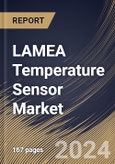In manufacturing environments, these sensors play a crucial role in maintaining optimal operating conditions for machinery and ensuring the quality and integrity of manufactured products. Precision and consistency are paramount when temperature sensors are employed in industries such as pharmaceuticals, food and beverage, petrochemicals, and more. In the automotive sector, temperature sensors are integral components that contribute to the efficiency and performance of vehicles. These sensors are used to monitor the temperature of engine components, exhaust systems, and cooling systems, preventing overheating and enhancing overall engine efficiency. Additionally, temperature sensors contribute to the optimal functioning of air conditioning and climate control systems within vehicles, enhancing the comfort and safety of occupants.
Temperature sensors are pivotal in healthcare applications, particularly medical devices, diagnostic equipment, and laboratory instruments. These sensors are crucial for monitoring the body temperature of patients, ensuring the effectiveness of medical treatments, and maintaining the integrity of sensitive biological samples in laboratories. The healthcare sector's increasing reliance on temperature-sensitive processes and equipment has driven the demand for advanced, accurate temperature-sensing technologies. As consumer electronics continue to advance, so does the demand for smaller, more accurate, and energy-efficient temperature sensors.
Temperature sensors find extensive use in industrial applications across Latin America, the Middle East, and Africa. These sensors are crucial for monitoring and controlling temperature in manufacturing processes, ensuring product quality and efficiency. Thus, the above aspects will expand the market growth across the region in the upcoming years.
The Brazil market dominated the LAMEA Temperature Sensor Market by Country in 2022, and would continue to be a dominant market till 2030; thereby, achieving a market value of $241.1 million by 2030. The Argentina market is showcasing a CAGR of 9.1% during (2023 - 2030). Additionally, The UAE market would register a CAGR of 8.2% during (2023 - 2030).
Based on Application, the market is segmented into Commercial (Aviation, Automobiles and Others) and Military. Based on Type, the market is segmented into Airborne, Marine, and Ground. Based on Component, the market is segmented into Hardware and Software. Based on Product, the market is segmented into Operator Training and System Testing. The report also covers geographical segmentation of Temperature Sensor Market. Based on countries, the market is segmented into Brazil, Argentina, UAE, Saudi Arabia, South Africa, Nigeria, and Rest of LAMEA.
List of Key Companies Profiled
- ABB Group
- Siemens AG
- Emerson Electric Co.
- Honeywell International, Inc.
- Microchip Technology Incorporated
- NXP Semiconductors N.V.
- Analog Devices, Inc.
- ON Semiconductor Corporation
- TE Connectivity Ltd.
- Texas Instruments Incorporated
Market Report Segmentation
By Type (Volume, Thousand Units, USD Billion, 2019-2030)- Contact
- Thermocouple
- Thermistor
- Resistance Temperature Detector (RTD)
- Bimetallic Temperature Sensor
- Others
- Non-Contact
- Infrared
- Others
- Consumer Electronics
- Oil & Gas
- Chemical
- Healthcare
- Automotive, Aerospace & Defense
- Energy & Power
- Food & Beverages
- Metals & Mining
- Others
- Brazil
- Argentina
- UAE
- Saudi Arabia
- South Africa
- Nigeria
- Rest of LAMEA
Table of Contents
Companies Mentioned
- ABB Group
- Siemens AG
- Emerson Electric Co.
- Honeywell International, Inc.
- Microchip Technology Incorporated
- NXP Semiconductors N.V.
- Analog Devices, Inc.
- ON Semiconductor Corporation
- TE Connectivity Ltd.
- Texas Instruments Incorporated








